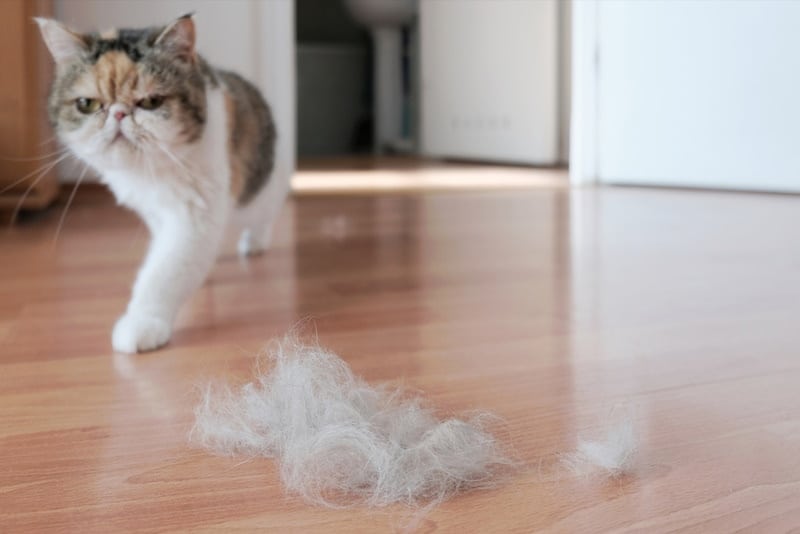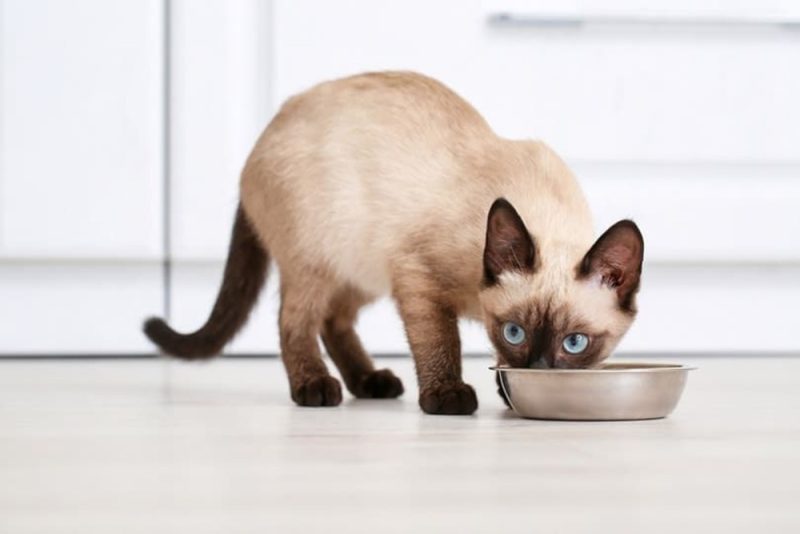Do you see little clumps of fur around your home? Is your cat mysteriously developing bald spots along their spine and perhaps other places like their legs and tail? These are all signs that something is wrong, and you should pay attention. There are many causes for cats pulling hair out along their spine.
You’ll need to determine the cause of the behavior first. Depending on the evidence, you might be able to take steps to correct it at home, like ridding the house of fleas. Many causes, however, will require the help of a vet.
Keep reading to learn more about the many reasons for this distressing behavior and what you can do about it.
The 8 Causes of Cats Pulling Hair Out Along Their Spine & What to Do
1. Fleas or Mites
Fleas are one of the most common reasons for overgrooming. Cats are typically allergic to flea saliva, causing skin irritation. Once they start overgrooming, the problem becomes much worse. The hair loss usually begins at the base of the spine near the tail and will spread as the flea infestation worsens, as fleas are most likely to reside there.
- If your cat is losing hair and has fleas, start with a veterinary consult. A veterinarian will prescribe a flea treatment plan appropriate for your cat. You should also thoroughly clean and disinfect your home. Getting rid of fleas in your home can take some time, but starting as soon as you notice them is best1.
- It is very important to note that the administration of flea drops without veterinary approval or a veterinarian’s prescription is illegal in most jurisdictions. In addition, fleas are very contagious. If you notice them on your cat, chances are your other pets have them, too. Therefore, you should have them all examined by a vet. Never use flea drops intended for dogs on cats, or vice versa.
If you need to speak with a vet but can't get to one, head over to PangoVet. It's an online service where you can talk to a vet online and get the advice you need for your pet — all at an affordable price!

2. Environmental Allergies (Atopic Dermatitis)
Even though cats have fur covering their skin, they can still come in contact with things that irritate them and cause a rash or other itchy reaction. They might rub against a toxic plant or be allergic to seasonal pollen they encounter while outdoors.
Many cats scratch their back along items they find particularly helpful, which could cause irritation along their spine and overgrooming when they become itchy.
- Gently part their fur to view the skin. Red, irritated skin indicates a rash or other reaction and should be evaluated by a veterinarian to determine the underlying cause. If it is atopic dermatitis (allergic reaction), it may be treated with oral medication or topical ointments. The vet may also run allergen tests on your cat to determine what causes their allergy. Avoiding known allergens is the best preventive measure for preventing an allergic reaction.
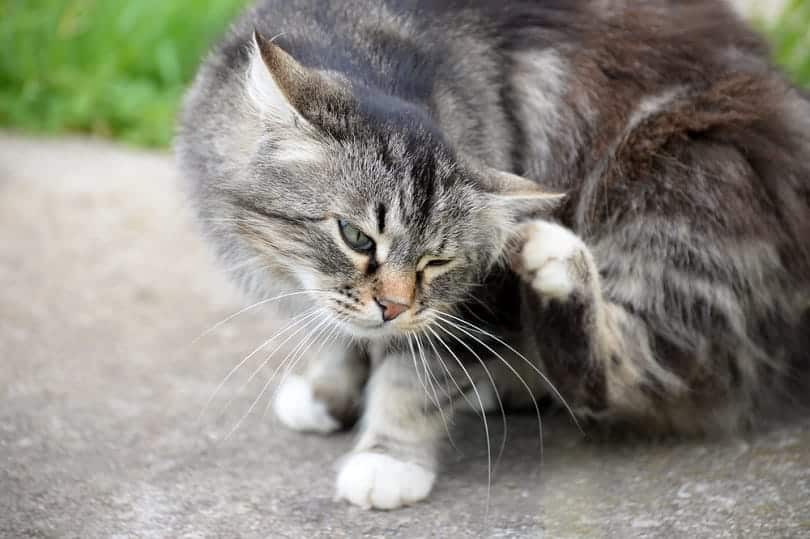
3. Food Allergies
A skin rash may also be caused by something they eat. This is similar in humans who break out in a rash or hives if they eat something they are allergic to. Some food reactions have very distinct signs, so recognizing them is easy2. Others will require more investigation. Reactions can also cause joint discomfort, including the spine, leading to overgrooming.
- Determining whether an environmental or food allergy causes skin irritation is challenging. If oral medication and topical ointments aren’t effective, it may be your cat’s food. Consult with a vet to determine if changing their food or trying an elimination diet could help identify which food they are allergic to.

4. Skin Infection
Skin infections, including fungal infections like ringworm, are particularly unpleasant3. Cats with skin infections regularly overgroom for two reasons. The first is instinctual to help rid themselves of the infection, and the second is to comfort the irritation.
The frustration at being unable to reach some areas, like the spine, could lead to overgrooming or pulling the hair out in the areas closest to it.
- Once you notice your cat overgrooming, check their skin for any signs of irritation or infection. Make an appointment with a vet for an evaluation so they can determine the type and the correct treatment. Every skin infection will require different medication, and some may require you to clean your home thoroughly to prevent it from spreading.
- Some skin infections in cats, such as the aforementioned ringworm, are zoonotic. This means you can catch them from your cat. You should thoroughly wash your hands before and after you touch your cat if you suspect they have a contagious skin disease. If the vet informs of you a definitive diagnosis, follow their advice on keeping yourself safe while your cat recovers.
5. Thyroid Problem
Hyperthyroidism in cats causes many distinct signs, including increased hunger and thirst, weight loss, aggression, vomiting, and diarrhea4. Another sign is that they may have a greasy and unkempt coat even though you see them overgrooming.
This condition causes the body’s metabolic rate to increase, and your cat may become very stressed, leading to unnecessary overgrooming.
- If your cat’s behavior changes or they start eating or drinking more than usual, you should get them to their vet as soon as possible. This is especially important if they are also losing weight. These could be signs of a thyroid problem. Fortunately, there are treatments that can help your cat feel better.
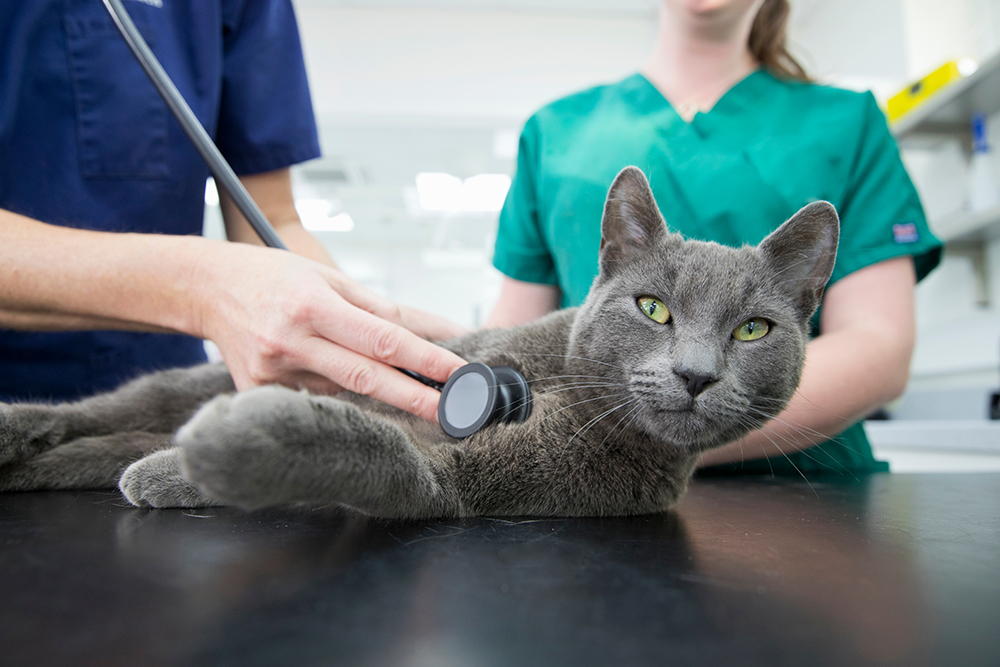
6. A Wound
Your kitty may be wounded for many reasons. Perhaps it was accidental while your cats played and got too rowdy. Or, maybe they got into a little misunderstanding with a cat outdoors about territory. It could also be a wound healing after surgery or other medical procedures.
No matter the cause, they will most likely want to lick the area instinctively to heal and relieve itching if it is located along the spine.
- Use a traditional cone or soft e-collar to prevent your cat from licking their wound. This will keep them from worsening it or causing a secondary infection.
- Contact a veterinarian for advice and treatment for your cat’s wound.
7. Pain
Licking is soothing for cats, and they will groom themselves for cleanliness and comfort. Overgrooming can be a sign of pain, which could be acute, like a UTI, or chronic, like arthritis. Excessive grooming along the spine may indicate that they are experiencing painful arthritis or have received a spinal injury.
- When you take your cat to the vet to determine the cause of your cat’s overgrooming, they will likely run diagnostic tests to rule out any acute or chronic conditions of the spine.

8. Stress or Anxiety (Psychogenic Alopecia)
Cats are creatures of habit, and it doesn’t take very much to cause anxiety. It may be as much as moving the food and water bowls or as big as bringing home a new pet. When a cat becomes stressed, it could cause them to overgroom.
While the most common areas are those that are easily reached, like the legs and flank, it can occur anywhere, including the spine.
- Most vets will only diagnose psychogenic alopecia once all medical diagnoses that can be treated have been ruled out. Then, you’ll need to help reduce their stress by keeping changes in the home to a minimum or introducing changes slowly, like moving a piece of furniture a little bit each day until it’s in a new position. You can also use pheromone sprays or medications to ease anxiety.

Conclusion
Many things can cause overgrooming and hair loss along the spine. The first step is to determine why it’s happening. Then, you will know how best to treat it so your kitty can get back to living comfortably, and you can relax knowing they are healthy.
If you ever have concerns about your cat’s physical or behavioral health, be sure to contact a vet.
Featured Image Credit: iwciagr, Shutterstock
